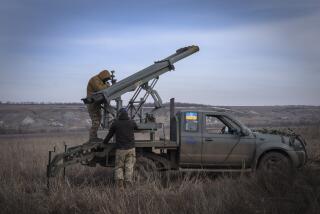Pentagon Revising Strategy to Curb Iraqi Resistance
WASHINGTON — Pentagon strategists are revamping their counterinsurgency plan in Iraq in response to a spate of deadly coordinated attacks against coalition forces and their allies, defense officials said Thursday.
U.S. military planners are speeding up training of Iraqi troops, intensifying sweeps and patrols through perilous neighborhoods in the “Sunni Triangle” and considering diverting troops from the Iraq Survey Group charged with searching for Saddam Hussein’s elusive arsenal of weapons of mass destruction, defense officials said.
For the record:
12:00 a.m. Nov. 6, 2003 For The Record
Los Angeles Times Thursday November 06, 2003 Home Edition Main News Part A Page 2 News Desk 1 inches; 40 words Type of Material: Correction
Iraqi weapons -- An article Friday in Section A about Pentagon strategies to curb Iraqi resistance included a quotation that referred to Iraqi “rockets and mortars that can reach 304 miles.” The quotation should have read “three to four miles.”
Defense Secretary Donald H. Rumsfeld explained during a Pentagon briefing Thursday how he intends to quickly build Iraqi security forces.
“You add money,” he said. “You set higher goals. You increase the number of Iraqis who are helping you doing the recruiting. You increase the number of countries who assist you with the training.”
The strategy pursued to date by the U.S. Central Command and approved by the Pentagon has been to launch raids to capture or kill enemy fighters while gradually increasing the number of Iraqi nationals in uniform -- of the army, police, paramilitary and border patrol.
After meeting this week with President Bush, national security advisor Condoleezza Rice and Iraq’s civilian administrator, L. Paul Bremer III, Rumsfeld intends to speed up the process.
Still, it is expected to take months to significantly increase the numbers of Iraqis on the front lines, as U.S. forces face up to three dozen assaults a day from an increasingly sophisticated and deadly insurgency. Military analysts say it will take many more months to improve what they describe as the biggest deficiency in the coalition’s counterinsurgency plan: its lack of intelligence sources who can direct U.S. troops to the enemy.
“We still haven’t got the military intelligence to do counterinsurgency in this region,” said Gordon Adams, director of Security Policy Studies at George Washington University.
“Counterinsurgency intelligence is not like other intelligence,” he said. “Infiltrating that kind of organization for intelligence purposes is extraordinarily hard. That has got to be the biggest challenge that American military intelligence faces here: ‘How do I get inside? How do I find out what’s going on?’ ”
Slow progress and a series of escalating bloody attacks against U.S. forces have driven down President Bush’s public approval ratings and prompted the White House to create the Iraq Stabilization Group, in which the National Security Council and State Department officials help to direct the Pentagon’s Iraq reconstruction program. Concern over Iraq, and Rumsfeld’s recent clashes with lawmakers on Capitol Hill over the war, also have tarnished his image as the administration’s biggest star, prompting Time magazine to ask, “Is Rumsfeld Losing His Mojo?” Mojo, a term popularized in the Austin Powers movies, translates roughly as charisma.
“Have you lost your mojo?” a reporter asked Rumsfeld during Thursday’s Pentagon briefing.
“I don’t know enough about mojo to know,” Rumsfeld replied.
Intelligence reports and public statements by administration officials have contradicted one another on who the enemy is, how many of the attackers are foreign fighters and where such key figures as Saddam Hussein are hiding. Asked Thursday what proportion of those captured in attacks on U.S. forces and their allies in Iraq are foreign nationals, Rumsfeld conceded, “I don’t have as good an answer as I ought to.”
Military strategists believe that their intelligence will improve as the number of Iraqi security forces on the ground rises. That number has climbed to 100,000 as American troop numbers have declined to about 130,000 from 150,000 at the peak of the war, Rumsfeld said. The approach is similar to the community policing strategy used by many U.S. police departments, putting officers in touch with residents both to improve relations and to glean information.
Yet replacing significant numbers of American troops with Iraqis will take time, and many analysts expect a U.S. troop presence to remain for years, perhaps indefinitely.
As the Pentagon waits for more Iraqis to join the front lines, it is relying heavily on technology to fight insurgents. The Defense Advanced Research Projects Agency hopes to ship sniper detection systems designed to locate gunmen in real time to Iraq by February.
It also hopes to deploy devices still under development that could detect electronics such as pagers and mobile phones, used by Iraqi guerrillas to set off crude roadside bombs that target convoys, the agency’s director, Anthony J. Tether, told reporters recently. The agency also is speeding development of a driverless vehicle.
However, progress in the war is likely to remain lethargic until the intelligence improves, said Andrew Bacevich, a foreign policy and national security analyst at Boston University.
“If we can’t find the enemy, how we go about doing it is less important,” he said.
The gaps include a lack of cooperative sources, insufficient expertise and language skills of U.S. military intelligence agents and inadequate preparation, said Anthony Cordesman, a former senior Pentagon official who is a military analyst on Iraq at the Washington-based Center for Strategic and International Studies.
“A lot of things can be fixed,” Cordesman said. “Now, that all depends on the skill with which we fix them.... While you can reduce the risk and you can protect individual areas better, in a country where there are this many arms and this many small cells and groups and this many rockets and mortars that can reach 304 miles, it’s virtually impossible to stop these attacks.”
More to Read
Sign up for Essential California
The most important California stories and recommendations in your inbox every morning.
You may occasionally receive promotional content from the Los Angeles Times.










